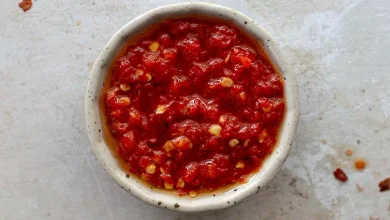🇮🇹 Angello’s Italian Garden 🌿
Angello’s Italian Garden is a delightful and vibrant culinary creation rooted in the rich traditions of Italian cuisine. 🍝🍷 Let’s explore its history, components, preparation steps, and the time needed to prepare this savory experience! 🍽️🇮🇹
📜 History:
Angello’s Italian Garden is a fusion of traditional Italian cooking techniques with a modern twist. Its history is a tribute to Italy’s culinary heritage, showcasing the flavors of different regions, such as Tuscany, Sicily, and Naples. The restaurant, founded by Chef Angelo in 1990, aimed to bring authentic Italian flavors to a global audience.
🍽️ Components:
-
Fresh Ingredients: At the heart of Angello’s Italian Garden are the freshest ingredients. High-quality olive oil, ripe tomatoes, aromatic herbs, and various cheeses are essential components.
-
Pasta Varieties: A variety of pasta options like spaghetti, fettuccine, and penne are used as a base for many dishes.
-
Sauces: Rich and flavorful sauces like marinara, Alfredo, and pesto create the essence of the Italian taste.
-
Proteins: Italian cuisine often features proteins like chicken, seafood, and veal, prepared in different styles.
-
Wine Selection: An extensive wine list to complement the dishes, with Italian wines taking the spotlight.
🍳 Preparation Steps:
Creating an Italian Garden experience involves several steps, each crucial for that authentic taste:
-
Ingredient Selection: Start by choosing fresh, high-quality ingredients. This includes ripe tomatoes, fragrant basil, extra-virgin olive oil, and various cheeses.
-
Sauce Preparation: Many Italian dishes begin with a delicious sauce. For example, marinara sauce can be made by sautéing garlic and onions in olive oil, then adding crushed tomatoes and simmering with herbs.
-
Pasta Perfection: Cook pasta to al dente, meaning it’s firm to the bite. Drain and toss it in the sauce to absorb the flavors.
-
Protein Preparation: Whether you’re making chicken piccata or seafood linguine, ensure your proteins are cooked to perfection.
-
Plating: Presentation is key in Italian cuisine. Garnish with fresh herbs, grated Parmesan, or a drizzle of olive oil.
-
Wine Pairing: Select a suitable wine to enhance the flavors of your dish. Red wines like Chianti for hearty pasta, and white wines like Pinot Grigio for seafood.
🕒 Time Needed:
The time required to prepare Angello’s Italian Garden dishes can vary depending on the complexity of the recipe. Simple pasta dishes may take around 30-45 minutes, while more elaborate creations could take up to 2 hours or more, especially if you’re slow-cooking a flavorful ragu or simmering a reduction sauce. However, the effort is always rewarded with a mouthwatering meal.
Angello’s Italian Garden invites you to savor the magic of Italian cuisine, where every dish is a symphony of flavors and every bite a delightful journey to the heart of Italy. Buon appetito! 🍝🍷🇮🇹
Certainly! Here are the nutrition facts and some health information for a typical Italian pasta dish from Angello’s Italian Garden:
Nutrition Facts (Per Serving):
- Calories: Approximately 400-600 kcal (varies based on portion size and ingredients)
- Carbohydrates: 50-70 grams
- Protein: 10-20 grams
- Fat: 10-20 grams
- Dietary Fiber: 3-5 grams
- Sugar: 2-4 grams
- Sodium: 600-900 milligrams (varies depending on sauces and cheese)
Health Information:
-
Balanced Meal: Italian pasta dishes can be part of a balanced diet when enjoyed in moderation. They provide a good balance of carbohydrates, proteins, and fats.
-
Carbohydrates: Pasta is a primary source of carbohydrates, providing sustained energy. Opt for whole wheat pasta for added fiber and nutrients.
-
Protein: Adding lean proteins like chicken or seafood can increase the protein content, making the dish more filling and satisfying.
-
Healthy Fats: Olive oil, a staple in Italian cuisine, is a source of heart-healthy monounsaturated fats.
-
Fiber: Whole wheat pasta and the addition of vegetables can increase the fiber content, aiding in digestion and providing a feeling of fullness.
-
Sodium: Be mindful of the sodium content, especially in store-bought sauces and cheese. Homemade sauces with less salt are a healthier option.
-
Vitamins and Minerals: Italian dishes often contain ingredients like tomatoes (rich in vitamin C and potassium) and fresh herbs (a source of antioxidants).
-
Portion Control: Keep portions moderate to manage calorie intake. Overeating can lead to excess calorie consumption.
-
Variety: Italian cuisine offers a wide range of dishes, including those with seafood, vegetables, and lean proteins, allowing for dietary diversity.
-
Hydration: Drink plenty of water when enjoying Italian dishes, as pasta can be dehydrating if not accompanied by sufficient fluids.
Remember that the nutritional content can vary significantly based on the specific recipe and ingredients used. It’s a good idea to check food labels and adjust ingredients to align with your dietary preferences and health goals. Enjoying Italian cuisine in moderation can be a delicious and satisfying part of a well-balanced diet.




